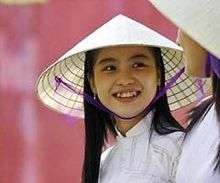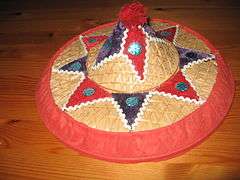Asian conical hat

The Asian conical hat, commonly known as an Asian rice hat, coolie hat (in the UK), or farmer's hat, is a simple style of conical hat originating in East, South, and Southeast Asia, particularly Bangladesh, Bhutan, China, Cambodia, India, Indonesia, Japan, Korea, Laos, Malaysia, Myanmar, Nepal, Philippines, parts of Russian Manchuria and Vietnam.
Practical uses
This style of hat is used primarily as protection from the sun and rain. When made of straw or matting, it can be dipped in water and worn as an impromptu evaporative-cooling device.[1]
In the Philippines, the plain type is typically worn by farmers, but nobles crafted an ornate variation with jewels or made of turtle shells and a spike on top. It was worn by native soldiers, particularly Tagalogs, Kapampangans, and Ilocanos of the Spanish Colonial Army during the later years of Spanish colonial period.
Similarly in India and Borneo, the plain conical hat was worn by commoners during their daily work, but more decoratively-colored ones were used for festivities. In Sabah the colorful conical hat is worn for certain dances while in Assam they are hung in homes as decoration or worn by the upper classes for special occasions.
In China, it was typically associated with farmers, while mandarins wore tighter circular caps, especially in the winter.[2]
Regional names
English terms for the hat include sedge hat, rice hat, paddy hat, bamboo hat and sometimes coolie hat.[3]
In Chinese, it is called dǒulì (斗笠), literally meaning a "one-dǒu bamboo hat", (笠帽, 竹笠). It is known as sugegasa (菅笠) in Japan, do'un (ដួន) in Cambodia, koup (ກຸບ) in Laos, khamauk (ခမောက်) in Myanmar, terendak in Malaysia, caping in Indonesia, and salakot in the Philippines. In Korean, the hat is called satgat (삿갓) or gaerip (개립, 蓋笠).
In Vietnam, the name is nón lá (leaf hat). Among conical hats, the nón lá of the Vietnamese people forms a perfect right circular cone which tapers smoothly from the base to the apex. Special conical hats in Vietnam contain colourful hand-stitch depictions or words while the Huế varieties are famous for their nón bài thơ (lit. poem conical hats). These contain random poetic verses and Hán tự which can be revealed when the hat is directed above one's head in the sunlight. Today, it has become part of Vietnam's national costume.
Gallery

 A decorative Assamese jaapi constructed primarily out of bamboo and leaf while the decorations are felt, threads and tin glitter.
A decorative Assamese jaapi constructed primarily out of bamboo and leaf while the decorations are felt, threads and tin glitter.
 Souvenir nón lá for tourists
Souvenir nón lá for tourists Sabah style conical hat in Malaysia
Sabah style conical hat in Malaysia- Tortoise-shell and silver salakot from the Philippines
 A silver-inlaid Filipino salakot fit for a Gobernadorcillo or a Cabeza de baranggay
A silver-inlaid Filipino salakot fit for a Gobernadorcillo or a Cabeza de baranggay A Korean in mourning clothes
A Korean in mourning clothes
See also
References
- ↑ "Conical Hats". Nguyentientam.com. Retrieved 2012-05-23.
- ↑ Encyclopædia Britannica, Eleventh Edition. New York: Encyclopædia Britannica, Inc. 1910. p. 173.
- ↑ "Coolie hat - Definition and More from the Free Merriam-Webster Dictionary".
External links
| Wikimedia Commons has media related to Conical straw hats. |